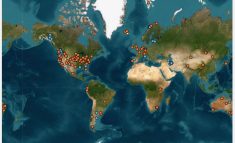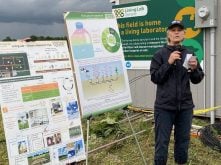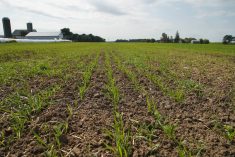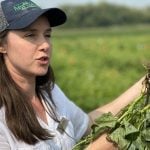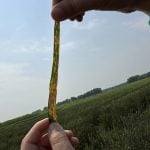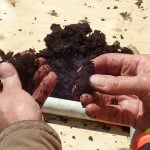Placing fertilizer where it can be best used by crops can reduce nitrous oxide emissions, says an Ontario company that is researching emissions related to its Innovative Fertile Strip system.
GPS Ontario is the contracted crop provider for Invest Ottawa’s AreaX.O, the former Ottawa research station now known as the Ottawa Smart Farm. It has also collaborated with University of Ottawa researchers on nitrous oxide (N2O) emissions studies using different cropping methods, including its Innovative Fertile Stripping (IFS) system, on approximately 120 acres.
Why it matters: Farmers are being pushed to reduce nitrous oxide emissions from fertilizer by 30 per cent, but there are still gaps in the technology needed to accomplish that goal.
Read Also
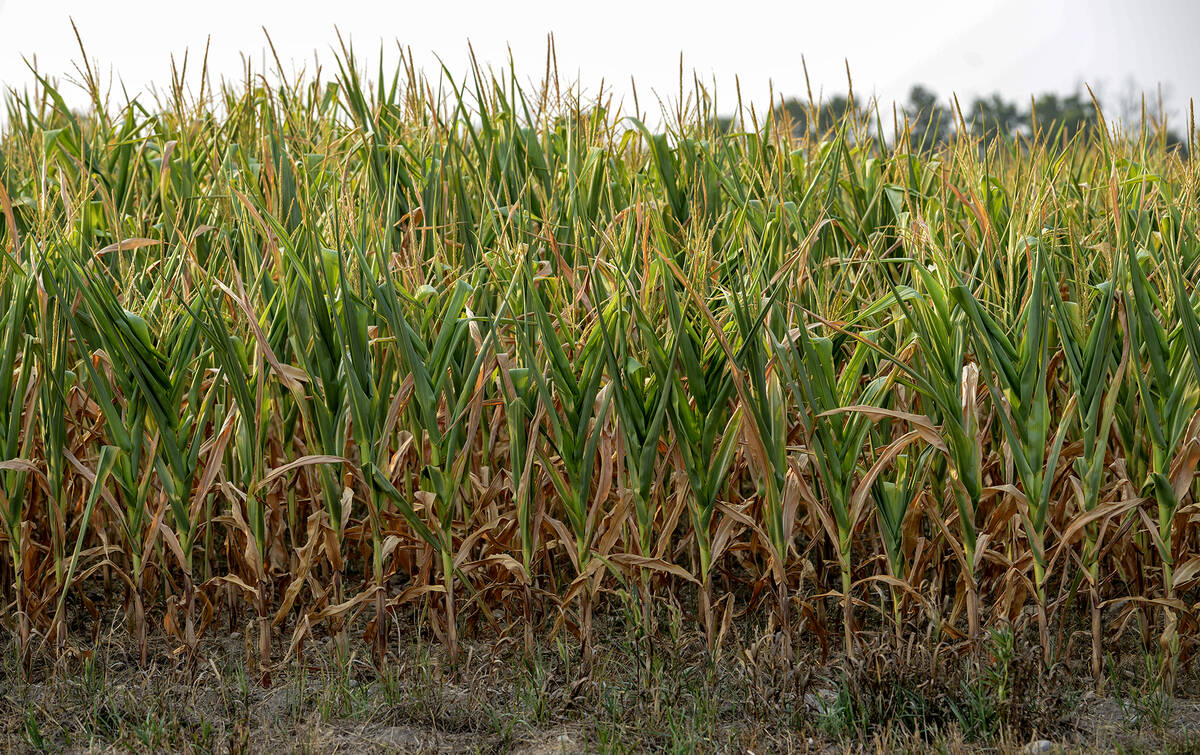
Extreme variability marks Ontario’s 2025 corn crop
The yield potential of Ontario’s 2025 corn crop was lost in some areas due to extreme dry conditions.
Fertile stripping creates a six-inch by six-inch flowerpot-style zone that evenly incorporates fertilizer around the seed in one pass, minimizing root burn and increasing nutrient efficiency and fertilizer access to moisture, soil and microbes.
“As soon as that root comes out of that seed, it finds fertilizer. Then, as those roots start growing and growing longer, it’s still finding food,” said Morley Wallace, GPS Ontario president and CEO. “We’re feeding that plant from day one, not day 10.”
[RELATED] Fertilizer emissions: it’s in the details
The fertile stripping process supplies the root with immediate and prolonged access to fertilizer. For example, if plants are seeded in the first week of May and followed by a 10-day rain delay, there is no difference in corn growth because corn sets up cob row numbers in the first 12 days of germination, said Wallace.
“We’re seeing a lot of cob development where we’re filling to the tip and beyond, and we’re using less fertilizer,” said Jordan Wallace, GPS Ontario sales and advanced solutions technician.
Innovative fertile stripping changes how farmers apply fertilizer and shifts the use of equipment by working only a fifth of the soil on 30-inch rows, creating healthier root zones and soil structure, said Wallace.
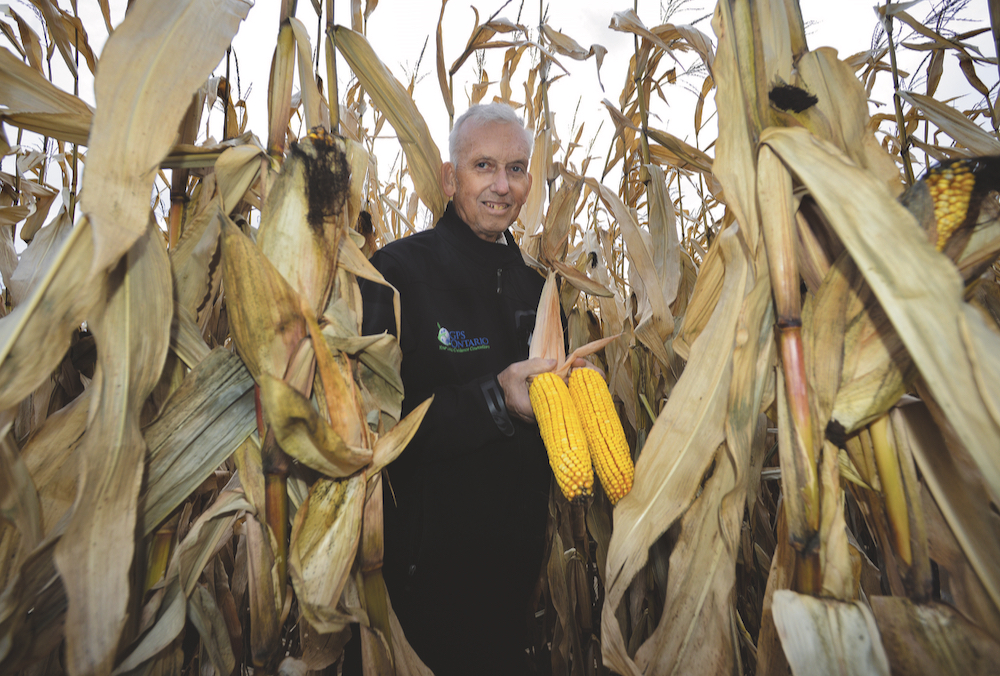
Each year the fertile strip moves 15 inches back and forth, allowing row soil to rest, earthworms to thrive, and remaining fertilizer to improve the soil.
Testing for yield lag in a mono-crop culture scenario, GPS Ontario grew five years of corn-on-corn on the North Gower farm using the fertile strip six-inch bands on 30-inch rows. Then it introduced soybeans for one year, returning to corn this year. There was no decrease in yield.
Now the firm is testing how to incorporate wheat in the rotation using fertile strips.
[RELATED] New professorship to lead teaching and research in sustainable cropping
Over the winter, Wallace engineered a three-product side-dress unit capable of delivering nitrogen to the root ball while simultaneously delivering a fungicide, insecticide or herbicide at varying rates.
It also addresses herbicide resistance via an automatic spot-spraying system that identifies weeds and sprays them directly.
“It’s expensive but being able to deliver an environmentally sustainable solution that can do three jobs in one pass, using the right rate of nitrogen at the right time because its autonomous rate changes, and deliver that to where the crop needs it, I think, will be a sustainable package,” said Wallace.
The Smart Farm launched in May 2020 to facilitate industry-led collaborations and drive innovation. It’s nestled within Invest Ottawa’s Area X.0’s 750-hectare all-weather R&D experimentation complex.
GPS Ontario is applying for another 500 acres at Area X.0 to increase academic partnerships and bring in more small- and medium-sized enterprises to test how to reduce nitrous oxide.
“We want to take the nitrous oxide project we’re working on right now and expand on it almost threefold, but the problem is the sensors are so expensive it’s hard to get that kind of funding,” said Jordan Wallace, adding there’s $700,000 wrapped up in sensors for the N2O project. “But out of that, we’re able to start showing some really incredible returns on investment.”
Wallace said early data results show fertilizer begins to break down at approximately day 10, and there is reduced N2O volatility through the innovative fertile strip system compared to other fertilizer delivery methods.
“We didn’t know that (when fertilizer broke down), but now we do,” said Morley Wallace. “Once we start reading the charts and the information, it all starts to make sense, and we can work with it.”
Canadian Federation of Agriculture vice-president Keith Currie sees the potential.
Suppose continued research validates fertile stripping’s one-pass system and results in better yield, quality and increased soil health while simultaneously lowering input costs, greenhouse gas emissions and environmental impact, he said. In that case, it has enormous potential, but more data is needed.
GPS Ontario recently hosted a tour of participants from the International Association of Programs for Agricultural Leadership. They showed interest in the IFS technology and Wallace’s three-product side-dress sprayer.
“Judging by the reaction to people (at GPS) to what they’re doing, it was all new,” said Currie. “They were quite fascinated.”
Currie said most of the European movement to reduce fertilizer impact was predicated around regulatory reform, forcing changes and sparking research and development.
Wallace said GPS Ontario research indicates farmers are over-fertilizing by 30 per cent.
Fertilizer Canada, which was part of Ottawa’s N2O project, pulled its funding this year, and GPS Ontario hasn’t been able to garner support from grain organizations either.
It has connected with University of Guelph professors and academia who may implement fertile strips in their research and replicate the Ottawa trials.
Wallace is creating accessible data on AreaX.0’s website to encourage collaboration and expand interest and investment. It includes 16 different field coverage maps with 50 layers of data per acre.
“Looking at the cost of production side, that’s where we start making farming more sustainable,” said Wallace. “We’re not burning as much fuel. We’re not buying as much equipment. I only need three pieces of equipment to farm, plus a combine and a sprayer, which we hire out.”
Once launched, Currie said he is confident GPS Ontario would qualify for some of the $1 billion in climate change initiative funding the government announced in the spring.
He added there’s an opportunity for Grain Farmers of Ontario and Grain Growers of Canada to play a critical role in meeting the government’s emission reduction goals by funding innovators and farm system research like the Innovative Fertile Strip system.
“We need groups like this to continue to do the research they need, and that takes money.”
Currie said GPS Ontario provides much-needed baseline data to plot how to achieve the government’s goal.
“We’ll get to 30 per cent, but if you don’t know where the hell you’re starting, how do you know when to get to the finish line?” Currie asked, “So how do we encourage and enhance more groups like that getting involved? Things like Living Labs, the supercluster, and Invest Ottawa venture centres are a good way to try and tackle that.”




